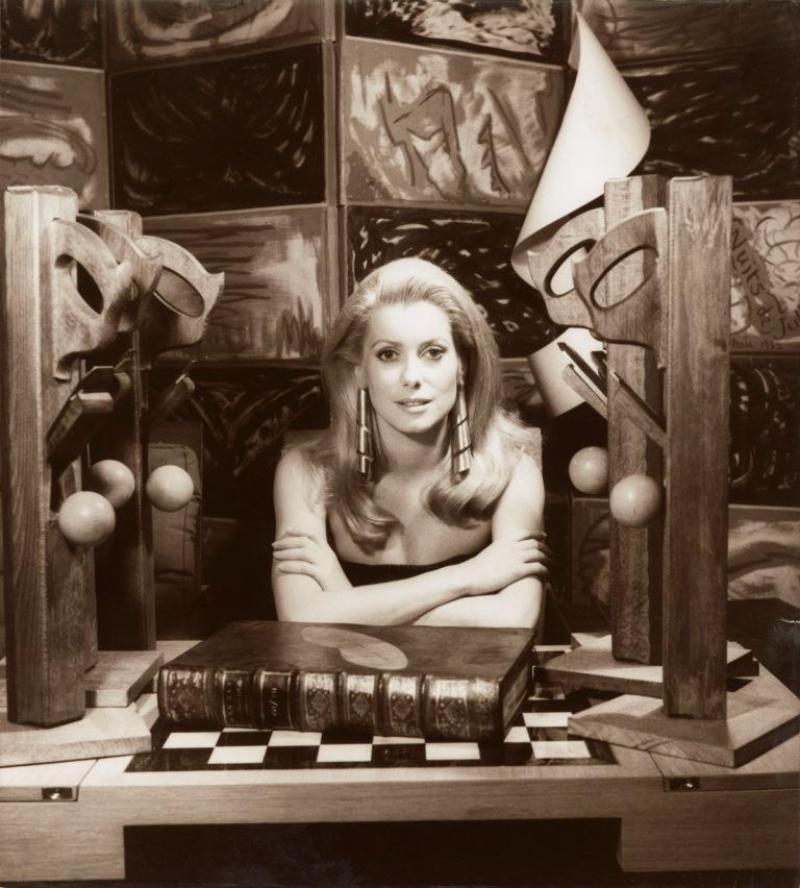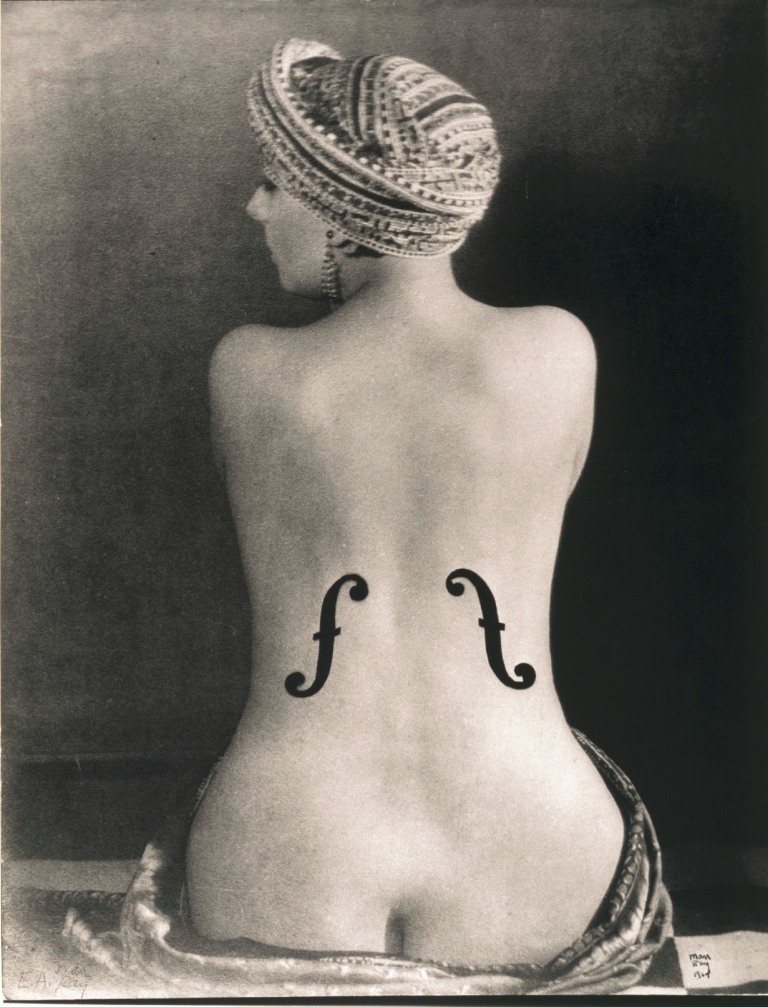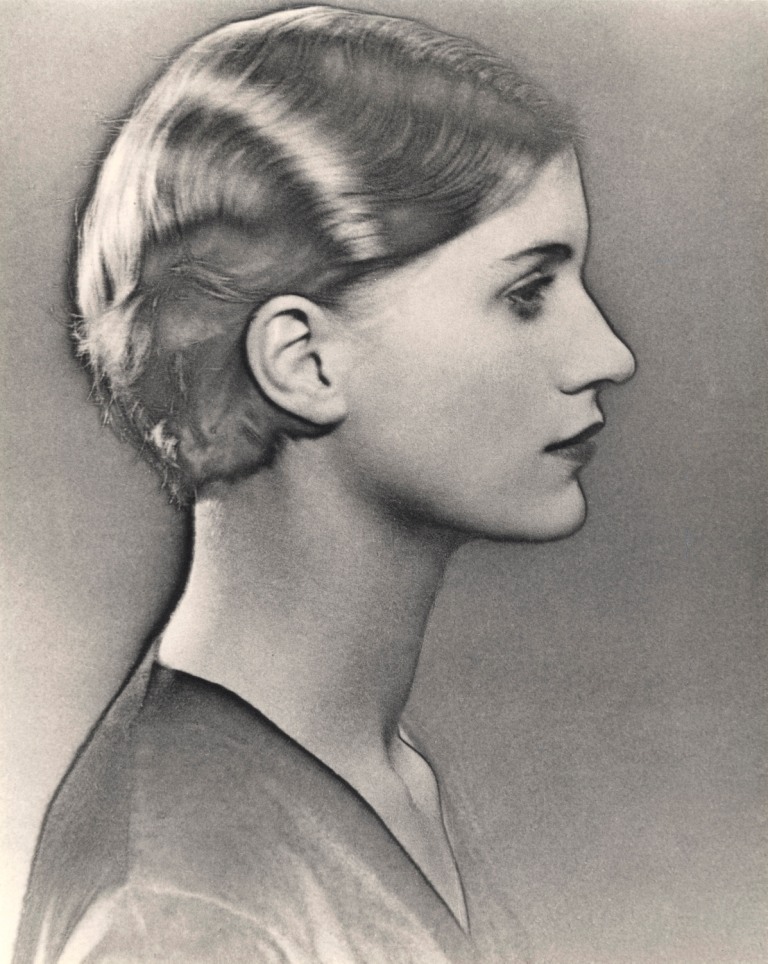Man Ray Portraits, National Portrait Gallery | reviews, news & interviews
Man Ray Portraits, National Portrait Gallery
Man Ray Portraits, National Portrait Gallery
Unforgettable images from the great days of modernist Paris

Travelling through Canada by train – more decades ago than I care to divulge here – I bought a book of Man Ray photographs at Banff in the heart of the Rockies. I spent the rest of the journey with one eye on the majestic mountains, and the other glued to the luminous, edgy, ineffably stylish images of the American surrealist in Paris.
Those images were pretty well-known then. They’re infinitely better known now. The "Ingres" woman with violin marks on her back (pictured below, Le Violon d’Ingres, 1924), the pale-faced Parisian beauty with the African mask, the solarised profile of Lee Miller: they’ve all become standbys for greetings cards and ready-framed pictures for first-time buyers. They’re still luminous, still ineffably stylish, but have they retained anything in the way of edge? Have Man Ray’s classic images been rendered tame by sheer over-familiarity?
 Incredibly this is the first major museum exhibition of Ray’s portraits. It starts with a small, but telling image: Marcel Duchamp in profile in 1916, looking rather monk-like in severe chiaroscuro. Ray – born Emmanuel Radnitzky in Philadelphia in 1890 – met Duchamp in New York around the time of the notorious Armory Show of 1913, and followed the French artist to Paris in 1921. Ray took up the camera to document his paintings and Dada pieces, but when the work in his first Paris exhibition didn’t sell, he developed photography as another revenue stream.
Incredibly this is the first major museum exhibition of Ray’s portraits. It starts with a small, but telling image: Marcel Duchamp in profile in 1916, looking rather monk-like in severe chiaroscuro. Ray – born Emmanuel Radnitzky in Philadelphia in 1890 – met Duchamp in New York around the time of the notorious Armory Show of 1913, and followed the French artist to Paris in 1921. Ray took up the camera to document his paintings and Dada pieces, but when the work in his first Paris exhibition didn’t sell, he developed photography as another revenue stream.
The images in the first few rooms show who he was mixing with: Picasso, Braque, Stravinsky, Tristan Tzara, Joyce, Hemingway, Cocteau, le Corbusier, Breton, Kiki de Montparnasse... and on and on. In other words, the usual suspects of early 20th-century Paris, seen in images that are in many cases extremely well known. Yet they regain their impact and freshness by being seen in original prints with their original tints and patinas. Ray’s famous image of Duchamp with a shooting star shaven into his hair is tiny – barely three inches high – in fading sepia. Nancy Cunard, her arms laden in exotic bangles – an image I would have been delighted never to have seen again – benefits from being seen smaller and murkier than expected. There’s a sense of going back to the source, of rifling through Ray’s filing cabinet.
 Ray had an extraordinary ability to design an image, to come up with a powerful visual concept that is generally breath-takingly simple. The Cunard image depends on the arms forming a severe right-angle. Iris Tree is seen in womanly soft focus with an almost Victorian romantic feel, while Schonberg, viewed in bullish head-on, is all heavy, saturated blacks. The solarised profile of Lee Miller, 1929 (pictured left) used on the poster combines an avant garde textural frisson with a classical clarity in its composition.
Ray had an extraordinary ability to design an image, to come up with a powerful visual concept that is generally breath-takingly simple. The Cunard image depends on the arms forming a severe right-angle. Iris Tree is seen in womanly soft focus with an almost Victorian romantic feel, while Schonberg, viewed in bullish head-on, is all heavy, saturated blacks. The solarised profile of Lee Miller, 1929 (pictured left) used on the poster combines an avant garde textural frisson with a classical clarity in its composition.
While these images evoke for us a vivid, bohemian world at loggerheads with bourgeois society, many were taken for mainstream publications such as Vogue and Harper’s Bazaar. A page of Vanity Fair from 1922, of people "we nominate for the hall of fame", shows Ray’s images of Picasso and Joyce alongside baseball player George Owen.
 There are Brits a plenty: Thomas Beecham, looking like a soft-focus, but satanic romantic lead, Diana Cooper, Wallis Simpson, Aldous Huxley and Virginia Woolf – the latter two snapped in a tent Ray erected in Bedford Square during a visit to London in 1934. Ever the watchful opportunist he did advertising work – shown here in original magazines, though it’s unastonishing – and fashion photography. But then when you only – or mostly – photograph classically beautiful women, everything starts to look like a fashion photograph. A gently sapphic shot of Nusch Eluard and Sonia Mosse entwining their blonde manes, which must have seemed daring at the time, now looks straight out of Vogue; though it says something for its timelessness that it could be used in Vogue tomorrow without editing.
There are Brits a plenty: Thomas Beecham, looking like a soft-focus, but satanic romantic lead, Diana Cooper, Wallis Simpson, Aldous Huxley and Virginia Woolf – the latter two snapped in a tent Ray erected in Bedford Square during a visit to London in 1934. Ever the watchful opportunist he did advertising work – shown here in original magazines, though it’s unastonishing – and fashion photography. But then when you only – or mostly – photograph classically beautiful women, everything starts to look like a fashion photograph. A gently sapphic shot of Nusch Eluard and Sonia Mosse entwining their blonde manes, which must have seemed daring at the time, now looks straight out of Vogue; though it says something for its timelessness that it could be used in Vogue tomorrow without editing.
So was Man Ray much more than the Juergen Teller or even the Mario Testino of his day? Well, the jury is out on Teller’s aesthetic value in the light of his current ICA show. And while most of us would struggle to bring to mind a single Man Ray painting, we’re all still looking endlessly at his photographs. To take just one example that creeps up on you two-thirds of the way through this show: his almost painfully over-seen picture of Picasso’s muse Dora Maar – seen on its side – still looks magnificently elegant and sultry. And it’s shown beside a truly electrifying portrait of the man himself. (Pictured above right, Self-Portrait, 1932)
There are images from Ray’s wartime years in Hollywood and from his return to Paris, including Catherine Deneuve snapped for the Sunday Times in 1968 (see main image). But it’s to that iconic, early modernist Paris with its extraordinary cast of larger-than-life geniuses that we keep returning – captured by a man who was at once an outsider and a central figure in that extraordinary, unrepeatable moment.
Share this article
Add comment
The future of Arts Journalism
You can stop theartsdesk.com closing!
We urgently need financing to survive. Our fundraising drive has thus far raised £49,000 but we need to reach £100,000 or we will be forced to close. Please contribute here: https://gofund.me/c3f6033d
And if you can forward this information to anyone who might assist, we’d be grateful.

Subscribe to theartsdesk.com
Thank you for continuing to read our work on theartsdesk.com. For unlimited access to every article in its entirety, including our archive of more than 15,000 pieces, we're asking for £5 per month or £40 per year. We feel it's a very good deal, and hope you do too.
To take a subscription now simply click here.
And if you're looking for that extra gift for a friend or family member, why not treat them to a theartsdesk.com gift subscription?
more Visual arts
 'We are bowled over!' Thank you for your messages of love and support
Much-appreciated words of commendation from readers and the cultural community
'We are bowled over!' Thank you for your messages of love and support
Much-appreciated words of commendation from readers and the cultural community
 Folkestone Triennial 2025 - landscape, seascape, art lovers' escape
Locally rooted festival brings home many but not all global concerns
Folkestone Triennial 2025 - landscape, seascape, art lovers' escape
Locally rooted festival brings home many but not all global concerns
 Sir Brian Clarke (1953-2025) - a personal tribute
Remembering an artist with a gift for the transcendent
Sir Brian Clarke (1953-2025) - a personal tribute
Remembering an artist with a gift for the transcendent
 Emily Kam Kngwarray, Tate Modern review - glimpses of another world
Pictures that are an affirmation of belonging
Emily Kam Kngwarray, Tate Modern review - glimpses of another world
Pictures that are an affirmation of belonging
 Kiefer / Van Gogh, Royal Academy review - a pairing of opposites
Small scale intensity meets large scale melodrama
Kiefer / Van Gogh, Royal Academy review - a pairing of opposites
Small scale intensity meets large scale melodrama
 Jenny Saville: The Anatomy of Painting, National Portrait Gallery review - a protégé losing her way
A brilliant painter in search of a worthwhile subject
Jenny Saville: The Anatomy of Painting, National Portrait Gallery review - a protégé losing her way
A brilliant painter in search of a worthwhile subject
 Abstract Erotic, Courtauld Gallery review - sculpture that is sensuous, funny and subversive
Testing the boundaries of good taste, and winning
Abstract Erotic, Courtauld Gallery review - sculpture that is sensuous, funny and subversive
Testing the boundaries of good taste, and winning
 Edward Burra, Tate Britain review - watercolour made mainstream
Social satire with a nasty bite
Edward Burra, Tate Britain review - watercolour made mainstream
Social satire with a nasty bite
 Ithell Colquhoun, Tate Britain review - revelations of a weird and wonderful world
Emanations from the unconscious
Ithell Colquhoun, Tate Britain review - revelations of a weird and wonderful world
Emanations from the unconscious
 Rachel Jones: Gated Canyons, Dulwich Picture Gallery review - teeth with a real bite
Mouths have never looked so good
Rachel Jones: Gated Canyons, Dulwich Picture Gallery review - teeth with a real bite
Mouths have never looked so good
 Yoshitomo Nara, Hayward Gallery review - sickeningly cute kids
How to make millions out of kitsch
Yoshitomo Nara, Hayward Gallery review - sickeningly cute kids
How to make millions out of kitsch
 Hamad Butt: Apprehensions, Whitechapel Gallery review - cool, calm and potentially lethal
The YBA who didn’t have time to become a household name
Hamad Butt: Apprehensions, Whitechapel Gallery review - cool, calm and potentially lethal
The YBA who didn’t have time to become a household name

Comments
I went to see a Man Ray photo